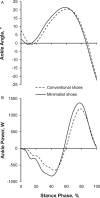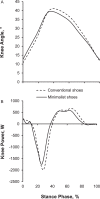Redistribution of Mechanical Work at the Knee and Ankle Joints During Fast Running in Minimalist Shoes - PubMed (original) (raw)
Redistribution of Mechanical Work at the Knee and Ankle Joints During Fast Running in Minimalist Shoes
Joel T Fuller et al. J Athl Train. 2016 Oct.
Abstract
Context: Minimalist shoes have been suggested as a way to alter running biomechanics to improve running performance and reduce injuries. However, to date, researchers have only considered the effect of minimalist shoes at slow running speeds.
Objective: To determine if runners change foot-strike pattern and alter the distribution of mechanical work at the knee and ankle joints when running at a fast speed in minimalist shoes compared with conventional running shoes.
Design: Crossover study.
Setting: Research laboratory.
Patients or other participants: Twenty-six trained runners (age = 30.0 ± 7.9 years [age range, 18-40 years], height = 1.79 ± 0.06 m, mass = 75.3 ± 8.2 kg, weekly training distance = 27 ± 15 km) who ran with a habitual rearfoot foot-strike pattern and had no experience running in minimalist shoes.
Intervention(s): Participants completed overground running trials at 18 km/h in minimalist and conventional shoes.
Main outcome measure(s): Sagittal-plane kinematics and joint work at the knee and ankle joints were computed using 3-dimensional kinematic and ground reaction force data. Foot-strike pattern was classified as rearfoot, midfoot, or forefoot strike based on strike index and ankle angle at initial contact.
Results: We observed no difference in foot-strike classification between shoes (χ21 = 2.29, P = .13). Ankle angle at initial contact was less (2.46° versus 7.43°; t25 = 3.34, P = .003) and strike index was greater (35.97% versus 29.04%; t25 = 2.38, P = .03) when running in minimalist shoes compared with conventional shoes. We observed greater negative (52.87 J versus 42.46 J; t24 = 2.29, P = .03) and positive work (68.91 J versus 59.08 J; t24 = 2.65, P = .01) at the ankle but less negative (59.01 J versus 67.02 J; t24 = 2.25, P = .03) and positive work (40.37 J versus 47.09 J; t24 = 2.11, P = .046) at the knee with minimalist shoes compared with conventional shoes.
Conclusions: Running in minimalist shoes at a fast speed caused a redistribution of work from the knee to the ankle joint. This finding suggests that runners changing from conventional to minimalist shoes for short-distance races could be at an increased risk of ankle and calf injuries but a reduced risk of knee injuries.
Keywords: foot strike; footfall; footwear; kinematics; kinetics.
Figures
Figure 1.
Group mean ankle-joint, A, angle and, B, power during a complete stance phase for minimalist and conventional shoes. Positive joint angles indicate ankle-joint dorsiflexion, and negative joint angles indicate ankle-joint plantar flexion. Positive joint power indicates generation of energy (concentric muscle action of ankle plantar-flexor muscles), and negative joint power indicates absorption of energy (eccentric muscle action of ankle plantar-flexor muscles).
Figure 2.
Group mean knee-joint, A, angle and, B, power during a complete stance phase for minimalist and conventional shoes. Positive joint angles indicate knee-joint flexion, and negative joint angles indicate knee-joint extension. Positive joint power indicates generation of energy (concentric muscle action of knee-extensor muscles), and negative joint power indicates absorption of energy (eccentric muscle action of knee-extensor muscles).
Similar articles
- Lower Extremity Biomechanics and Self-Reported Foot-Strike Patterns Among Runners in Traditional and Minimalist Shoes.
Goss DL, Lewek M, Yu B, Ware WB, Teyhen DS, Gross MT. Goss DL, et al. J Athl Train. 2015 Jun;50(6):603-11. doi: 10.4085/1062-6050.49.6.06. J Athl Train. 2015. PMID: 26098391 Free PMC article. - Lower extremity biomechanical relationships with different speeds in traditional, minimalist, and barefoot footwear.
Fredericks W, Swank S, Teisberg M, Hampton B, Ridpath L, Hanna JB. Fredericks W, et al. J Sports Sci Med. 2015 May 8;14(2):276-83. eCollection 2015 Jun. J Sports Sci Med. 2015. PMID: 25983575 Free PMC article. - Acute shoe effects on Achilles tendon loading in runners with habitual rearfoot strike pattern.
Zhang X, Deng L, Yang Y, Li L, Fu W. Zhang X, et al. Gait Posture. 2020 Oct;82:322-328. doi: 10.1016/j.gaitpost.2020.09.027. Epub 2020 Sep 29. Gait Posture. 2020. PMID: 33022565 - Injuries And Footwear (Part 2): Minimalist Running Shoes.
Knapik JJ, Orr R, Pope R, Grier T. Knapik JJ, et al. J Spec Oper Med. 2016 Spring;16(1):89-96. J Spec Oper Med. 2016. PMID: 27045504 Review. - Orthopaedic Perspective on Barefoot and Minimalist Running.
Roth J, Neumann J, Tao M. Roth J, et al. J Am Acad Orthop Surg. 2016 Mar;24(3):180-7. doi: 10.5435/JAAOS-D-14-00343. J Am Acad Orthop Surg. 2016. PMID: 26808173 Review.
Cited by
- The effect of footwear on mechanical behaviour of the human ankle plantar-flexors in forefoot runners.
Bonacci J, Spratford W, Kenneally-Dabrowski C, Trowell D, Lai A. Bonacci J, et al. PLoS One. 2022 Sep 19;17(9):e0274806. doi: 10.1371/journal.pone.0274806. eCollection 2022. PLoS One. 2022. PMID: 36121825 Free PMC article. - Flat flexible school shoes for adolescents with patellofemoral pain: a randomised, assessor-blinded, parallel-group feasibility trial.
Mazzella N, Fox A, Trowell D, Saunders N, Vicenzino B, Bonacci J. Mazzella N, et al. BMJ Open Sport Exerc Med. 2023 Nov 8;9(4):e001717. doi: 10.1136/bmjsem-2023-001717. eCollection 2023. BMJ Open Sport Exerc Med. 2023. PMID: 37953970 Free PMC article. - Systematic Review of the Role of Footwear Constructions in Running Biomechanics: Implications for Running-Related Injury and Performance.
Sun X, Lam WK, Zhang X, Wang J, Fu W. Sun X, et al. J Sports Sci Med. 2020 Feb 24;19(1):20-37. eCollection 2020 Mar. J Sports Sci Med. 2020. PMID: 32132824 Free PMC article. - Full Step Cycle Kinematic and Kinetic Comparison of Barefoot Walking and a Traditional Shoe Walking in Healthy Youth: Insights for Barefoot Technology.
Xu Y, Hou Q, Wang C, Sellers AJ, Simpson T, Bennett BC, Russell SD. Xu Y, et al. Appl Bionics Biomech. 2017;2017:2638908. doi: 10.1155/2017/2638908. Epub 2017 Nov 7. Appl Bionics Biomech. 2017. PMID: 29238158 Free PMC article.
References
- Lieberman DE, Davis IS, Nigg BM. Introduction: the past, present, and future of research on running barefoot and in minimal shoes. J Sport Health Sci. 2014; 3 2: 65– 66.
- Lieberman DE, Venkadesan M, Werbel WA, et al. Foot strike patterns and collision forces in habitually barefoot versus shod runners. Nature. 2010; 463 7280: 531– 535. - PubMed
- Perl DP, Daoud AI, Lieberman DE. Effects of footwear and strike type on running economy. Med Sci Sports Exerc. 2012; 44 7: 1335– 1343. - PubMed
- Paquette MR, Zhang S, Baumgartner LD. Acute effects of barefoot, minimal shoes and running shoes on lower limb mechanics in rear and forefoot strike runners. Footwear Sci. 2013; 5 1: 9– 18.
- Squadrone R, Rodano R, Hamill J, Preatoni E. Acute effect of different minimalist shoes on foot strike pattern and kinematics in rearfoot strikers during running. J Sports Sci. 2015; 33 11: 1196– 1204. - PubMed
MeSH terms
LinkOut - more resources
Full Text Sources
Other Literature Sources
Medical
Miscellaneous

